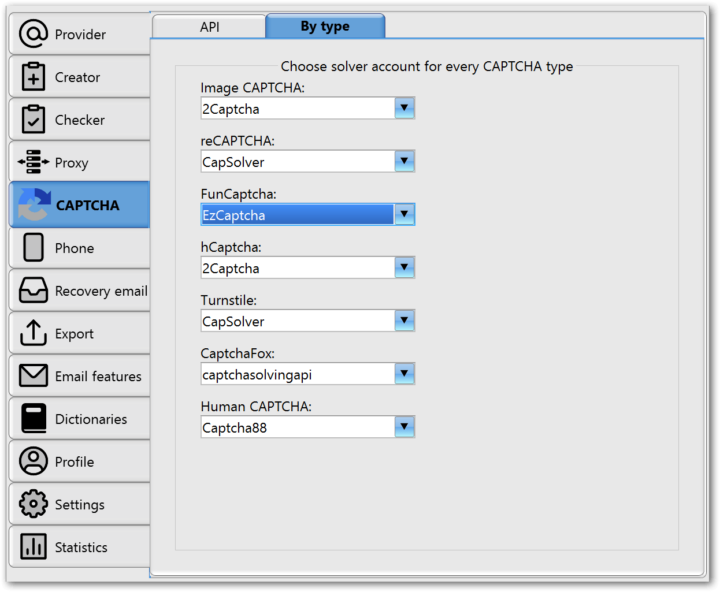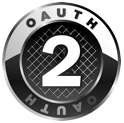MailBot has been updated to version 17.36.
By popular demand a choice of CAPTCHA solver for each type of CAPTCHA separately has been implemented:

The drop-down lists list the names of accounts that were previously added on the “API” subtab. This setting is very useful for email providers that use several types of CAPTCHA, for example GMX.com: CaptchaFox is used when creating an account, and an image CAPTCHA is used to activate email protocols (IMAP/POP3/SMTP). Previously, you had to either select a service that can solve both of these types of CAPTCHA (for example, 2Captcha), or first create accounts without activating email protocols, and later activate them with a checker, choosing another CAPTCHA solver. Now you can simply select the best solver in your opinion for each type of CAPTCHA separately, and it will always be used when a CAPTCHA of the corresponding type appears.
Outlook
Outlook has almost completely switched to a new protection when creating accounts: Human CAPTCHA. Previously, it was called PerimeterX, so Read more »
tavel
\\ 24captcha.online, AOL, API, CAPTCHA, Captcha88, GMX Europe, GMX.com, GMX.de, hCaptcha, Human CAPTCHA, I.UA, Mail.com, MailBot, OAuth2, onlinesim, Outlook, ruCaptcha, Web.de, Yahoo, creator, checker, экспорт
MailBot has been updated to version 17.21.
It is a well-known fact that for access via IMAP/POP3/SMTP to Yahoo/AOL accounts, you have long been required to create an application password, and for new accounts this function is disabled by Yahoo until 14 days have passed since the account was created. Even if you try to create such a password manually in the browser on an account less than 14 days old, you will get the error “Sorry, this feature is not available right now!”.
Of course, you can create an application password with the MailBot checker after 14 days, but this creates great inconvenience. But a solution has been found, and it is OAuth. Using the OAuth refresh token, which can now be generated by the Yahoo creator and checker in MailBot, you can access Yahoo accounts via IMAP/POP3/SMTP immediately after creating an account!
Everything works the same as for Outlook, just the “Generate OAuth2 refresh token” checkbox on the “Email features” tab is now available for Yahoo as well.
OAuth2 refresh token for Yahoo account looks like this:
AEawIGjLwMLD4B80rfvpr9Yhk2Si~001~YApSpi7faQ2Gh1POiyxbQc4-
All tokens are created for Mozilla ThunderBird client data, namely:
ClientId: dj0yJmk9NUtCTWFMNVpTaVJmJmQ9WVdrOVJ6UjVTa2xJTXpRbWNHbzlNQS0tJnM9Y29uc3VtZXJzZWNyZXQmeD0yYw--
ClientSecret: f2de6a30ae123cdbc258c15e0812799010d589cc
By the way, to prevent the Yahoo creator from throwing up errors about the impossibility of creating an application password after creating an account, you can run MailBot with the following command line options:
MailBot.exe /apppass:off /POP3:off /IMAP:off /SMTP:off
Yahoo/AOL
Fixed:
- SMS deliverability to phone numbers
- thread loop on error Read more »
tavel
\\ AOL, CaptchaFox, captchasolvingapi, CLI, funcaptcha, GMX Europe, GMX.com, IMAP, KoCaptcha, Mail.com, MailBot, Mg-Captcha, OAuth2, POP3, ruCaptcha, Runbox, SCTG, SMS-Activate, SMTP, Yahoo, checker, экспорт
MailBot has been updated to version 17.2.
The “GMX.fr” provider in MailBot has been renamed to “GMX Europe”.
It also now supports two new domains: gmx.co.uk and gmx.es.
The price of the provider has increased from $67 to $97.
Outlook
Handling of the error HTTP/1.1 503 Service Unavailable with the text Our services aren't available right now is implemented in the account creator.
Fixed:
- unlocking accounts with a
/recover lock type, where password change is required after completing SMS verification
- fingerprint generation in checker/unlocker
- country code transfer for United Kingdom in unlocker
Yahoo/AOL.com
Creators now successfully differentiate between invalid CAPTCHA code (ECAPTCHAWrongCode) and already used phone number (EEmailAPIPhoneUsedNumber) errors, rather than always generating EEmailAPIPhoneUsedNumber. This allows to diagnose problems with the reCAPTCHA Enterprise solution used by Yahoo/AOL.
If you are constantly getting ECAPTCHAWrongCode errors when creating Yahoo/AOL accounts, you need to Read more »
tavel
\\ AOL, CheapSMS, GMX Europe, gmx.co.uk, GMX.com, gmx.es, GMX.fr, inbox.lv, Mail.com, MailBot, Outlook, reCAPTCHA Enterprise, ReceiveBox, ruCaptcha, SMSBower, SMSHUB, Yahoo, creator, unlocker, proxy, судья прокси, checker
MailBot has been updated to version 16.67.
Due to numerous customer complaints about manual and slow updating of the list of available countries of phone numbers for various phone verification providers, dynamic loading of this list via API has been implemented in MailBot.
To date, this method is available and implemented for the following APIs:
Outlook
Fixed:
Unknown signup error with code 100 error in creatorUnable to verify account error in checker/unlocker, which occurred due to unsuccessful processing of “We’re updating our terms” form- error with code 6002 when verifying recovery email in unlocker
Yahoo/AOL.com
Fixed Unable to check account error in the checker.
GMX.com/Mail.com
An optional Read more »
tavel
\\ 5SIM, AOL, API, CapBypass, GMX.com, Hotmail, inbox.lv, Mail.com, Mail.ru, MailBot, Outlook, Runbox, sms-acktiwator, SMS-Activate, VAK-SMS, Yahoo, unlocker, checker, Yandex
MailBot has been updated to version 16.57.

This article is a continuation of the previous one, about adapting MailBot to mandatory authentication via OAuth2 for Outlook mail servers.
A new setting “Generate OAuth2 refresh token” has been added to the “Email Features” tab:

This setting currently only works for the Outlook/Hotmail module. If the checkbox is checked, the Outlook creator will generate OAuth2 tokens for accessing mail protocols after successfully creating an account, and the checker will generate them after successfully logging into an existing account.
Attention! All OAuth2 tokens are generated for ClientId 9e5f94bc-e8a4-4e73-b8be-63364c29d753, which is the ClientId of the Mozilla ThunderBird IMAP client in Outlook.
After successfully receiving OAuth2 tokens, MailBot will append a refresh token string to the end of the account string, and will also additionally save all parameters received from the OAuth2 server to a JSON file in the “oauth2” folder inside the “Accounts” folder. The file name will match the account email address. Example of the contents Read more »
tavel
\\ AOL, GMX.com, Hotmail, IMAP, Mail.ru, MailBot, OAuth2, OTPTextnow, Outlook, POP3, PVA, VAK-SMS, creator, recovery email
Page 1 from 712345...»Last »
|




 EzCaptcha — buy FunCaptcha Outlook/Twitter from $1.2/1K!
EzCaptcha — buy FunCaptcha Outlook/Twitter from $1.2/1K! RemProxy — budget, nimble proxies for any task
RemProxy — budget, nimble proxies for any task Blurpath — Best Quality Residential IPs-Fast & Affordable. 30% off sale, only $5/lP
Blurpath — Best Quality Residential IPs-Fast & Affordable. 30% off sale, only $5/lP The largest pool of residential proxies from $1.2. GEO. HTTP|SOCKS4/5
The largest pool of residential proxies from $1.2. GEO. HTTP|SOCKS4/5 MailerKing — best SMTP and webmailer ever!
MailerKing — best SMTP and webmailer ever!

